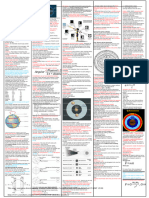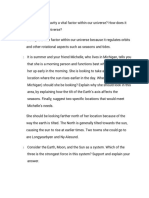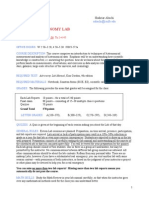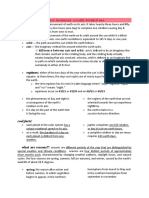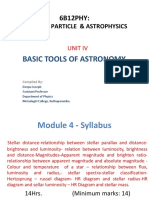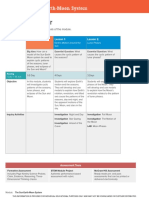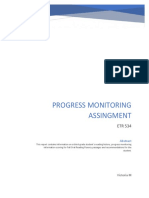Autumn Night Sky
Autumn Night Sky
Uploaded by
Hartford CourantCopyright:
Available Formats
Autumn Night Sky
Autumn Night Sky
Uploaded by
Hartford CourantOriginal Description:
Copyright
Available Formats
Share this document
Did you find this document useful?
Is this content inappropriate?
Copyright:
Available Formats
Autumn Night Sky
Autumn Night Sky
Uploaded by
Hartford CourantCopyright:
Available Formats
Astronomy
Common Core State Standard
CT Science Standards: 2.1, 3.1, 4.1, 5.3
Common Core Standards: RI (Reading Standards for Informational Text): grades 3-5(1,2,3,5,7) and RF (Reading Standards for Foundational Skills): grades 2-5(4)
The Autumn Night Sky: Shapes to Find!
Written by Noreen Grice, Travelers Science Dome Planetarium
The refreshing autumn air welcomes sky watchers to a season of transition. Did you know that you can see star patterns
of both summer and fall? Let’s take a look at the early evening skies in October through November and check
out those star patterns.
The first thing you’ll want to do is to figure out in which direction you are looking. Time to make a human com-
pass! Extend your arms from your sides and turn your body so that your right arm points in the direction where
the sun set; this should be approximately west. When your right arm is pointing west, your left arm will be point-
ing east. You are now facing south and north is behind you.
Look toward the southwest for three bright stars forming the shape of a triangle. This asterism is called the Sum-
mer Triangle. An asterism is a pattern of stars that is not a constellation but part of one (or more). In this case,
these three stars are in three separate constellations.
The Triangle’s top right corner star is called Vega, and it is the brightest star in the constellation called Lyra the
Harp. Look for a small parallelogram with a curved handle above that outlines this musical instrument. The top
left corner star of the Triangle is called Deneb, and it is the brightest star in the constellation Cygnus the Swan.
Some people also call this star pattern the “northern cross” because it looks like a long line with an intersecting
shorter line. The Triangle’s third, lowest corner, star is Altair—the eye of Aquila the Eagle. Can you imagine an
eagle sitting on a branch?
Now that we have a Summer Triangle, let’s find an Autumn Square. Look high toward the southeast for the stars of the Great Square of Pegasus. According to Greek
legend, Pegasus was a winged horse. From our perspective, Pegasus is flying upside down. The two lower corner stars outline his back and connect (to the right) to
his long curved head. The two upper corner stars form his chest. To the right of these stars are the stars that form his galloping front legs. The stars to the left form his
galloping back legs.
If a flying horse is too complicated to image, try this. Picture a baseball diamond with one star for each base plus home plate. It’s a popular game because all the
stars have come out to watch!
Here’s one more pattern. Find the area midway between the Summer Triangle and the Autumn Square. Now scan down toward the Southern horizon and stop when
you find a pattern that looks like a baby’s diaper. This is Capricornus the sea goat, but it really looks more like a diaper! This is a chal-
lenging pattern to find because it is much lower in the sky. You might not be able to see it if there is a house in the way. So, think of
Capricornus as your big challenge this season!
Did You Know Fun Things To Do
Go outside and check out the sky with an empty paper towel tube. Count stars in differ-
All the stars you see at night are part of our ent directions. Did you find the same amount of stars visible everywhere?
Milky Way Galaxy. Galaxies are like “star
cities” in the universe because they are col-
lections of hundreds of millions or billions
of stars. It’s hard to know exactly how many
Special Event!
stars make up the Weather permitting; get up early to see the total lunar eclipse on the morning of Oct 8th. For
Milky Way, but observers in New England, totality (when the Full Moon completely enters the Earth’s shadow)
astronomers have begins about twenty minutes before sunrise. The Moon will be very low and near setting, so try
to watch this event from a location with a clear view of the western horizon.
estimated there are
between 200 bil- Visit the New Children’s Museum in West Hartford!
lion and 400 billion
stars. Our Sun is one • Journey beyond Connecticut in the Traveler’s Science Dome.
of those stars. • Check out photographs of the night sky along the Museum’s pendulum stairway.
You might also like
- Phys1002 Cheatsheet FinalDocument5 pagesPhys1002 Cheatsheet FinalFiddin IchwanulNo ratings yet
- Alteryx PPTDocument13 pagesAlteryx PPTZain IqbalNo ratings yet
- Astronomy Unit 3 Critical Thinking QuestionsDocument3 pagesAstronomy Unit 3 Critical Thinking QuestionsDAKOTA FISHERNo ratings yet
- Astronomy LabDocument8 pagesAstronomy LabSukhdeep KaurNo ratings yet
- Superior Court Ruling On Church of The Woods ProposalDocument101 pagesSuperior Court Ruling On Church of The Woods ProposalBeau YarbroughNo ratings yet
- 1IntroductionTheSun PDFDocument19 pages1IntroductionTheSun PDFAastha JoshiNo ratings yet
- Csulb: Astr 100L Astronomy LabDocument3 pagesCsulb: Astr 100L Astronomy LabJayMShizzleNo ratings yet
- SpaceX - WikipediaDocument49 pagesSpaceX - Wikipediacrm testNo ratings yet
- Nov. 15 2021 Recusal ListDocument3 pagesNov. 15 2021 Recusal ListHartford CourantNo ratings yet
- Assignment On GoogleDocument6 pagesAssignment On GoogleHabib ZibranNo ratings yet
- The Cycles of The SkyDocument48 pagesThe Cycles of The SkyNatasya RosadiniNo ratings yet
- Night Sky: From Wikipedia, The Free EncyclopediaDocument5 pagesNight Sky: From Wikipedia, The Free EncyclopediaZoth BernsteinNo ratings yet
- Star Life CycleDocument2 pagesStar Life CycleTrixia AmorNo ratings yet
- SCIENCE 11.3 Phases Eclipses TidesDocument27 pagesSCIENCE 11.3 Phases Eclipses TidesLe Khanh Linh LouiseNo ratings yet
- Princess Solar SystemDocument32 pagesPrincess Solar SystemMary Jane AguilarNo ratings yet
- Class8 AstronomyDocument69 pagesClass8 AstronomyNikita AgrawalNo ratings yet
- Summative Test No 6 Refelction Refraction Transmission and AbsorptionDocument3 pagesSummative Test No 6 Refelction Refraction Transmission and AbsorptionGeri Isabel TampusNo ratings yet
- Lab SheetDocument1 pageLab SheetgladysNo ratings yet
- Astrophysics Option-DDocument36 pagesAstrophysics Option-DTaksh PathakNo ratings yet
- Current Affairs/GK: SpaceDocument44 pagesCurrent Affairs/GK: SpaceAahana BatraNo ratings yet
- Moons and PlanetsDocument46 pagesMoons and PlanetsCearra Mae EbronaNo ratings yet
- Module 1 Space EnvironmentDocument9 pagesModule 1 Space EnvironmentPrajwal B NaikNo ratings yet
- The Various Types of Galaxies: by Alec RodriguezDocument6 pagesThe Various Types of Galaxies: by Alec RodriguezAlecNo ratings yet
- Assignment Question POFDocument8 pagesAssignment Question POFAidil Idzham100% (1)
- Space and CuriosityDocument21 pagesSpace and CuriosityVIVEK MURTINo ratings yet
- Total Lunar EclipseDocument3 pagesTotal Lunar EclipseShayan ZafarNo ratings yet
- Exploring The Night Sky Lab 2Document2 pagesExploring The Night Sky Lab 2humza sattiNo ratings yet
- Solar SystemDocument39 pagesSolar SystemJL LeysonNo ratings yet
- 1.5 ForcesDocument19 pages1.5 ForceskookiemonsterNo ratings yet
- Our Universe Book NDocument49 pagesOur Universe Book NPadmaja Bhasuru100% (1)
- Module 2-Magnitude Systems & Stellar DistancesDocument132 pagesModule 2-Magnitude Systems & Stellar DistancesDeepu JosephNo ratings yet
- The Hertzsprung-Russell Diagram: in The Life Cycles of The StarsDocument16 pagesThe Hertzsprung-Russell Diagram: in The Life Cycles of The Starssidharth kashyapNo ratings yet
- Space TechnologyDocument41 pagesSpace Technologyudhaya nilavan25No ratings yet
- The SunDocument40 pagesThe SunKaren Vanessa Magada MendozaNo ratings yet
- Coriolis EffectDocument14 pagesCoriolis EffectABCDNo ratings yet
- LESSON 3 4th QUarter Eclipses PSDocument3 pagesLESSON 3 4th QUarter Eclipses PSKhate G. PrestozaNo ratings yet
- AstrophysicsDocument33 pagesAstrophysicsMerliahNo ratings yet
- Science Document. A Really Detailed One.: EquinoxDocument20 pagesScience Document. A Really Detailed One.: Equinoxmonique100% (1)
- A CubeSat Constellation For Integrated Earth Observationand Marine - Air Traffic MonitoringmainDocument13 pagesA CubeSat Constellation For Integrated Earth Observationand Marine - Air Traffic MonitoringmainJuan Antonio SanchezNo ratings yet
- SpaceRoboticsandAssociatedSpaceTechnol IjarchapterDocument21 pagesSpaceRoboticsandAssociatedSpaceTechnol IjarchapterPedroNo ratings yet
- Unit 6 - Space PhysicsDocument14 pagesUnit 6 - Space Physicseshal meNo ratings yet
- Solar and Lunar EclipsesDocument19 pagesSolar and Lunar EclipsesMuhammad Javaid100% (1)
- Lunar Eclipse: For Other Uses, See - Not To Be Confused WithDocument8 pagesLunar Eclipse: For Other Uses, See - Not To Be Confused WithVajith_Raghman_7390No ratings yet
- Unit IV-Basic Tools of AstronomyDocument110 pagesUnit IV-Basic Tools of AstronomyAnupriya AnuNo ratings yet
- Five Millennium Catalog of Lunar EclipsesDocument287 pagesFive Millennium Catalog of Lunar EclipsesAstronomia no VerdeNo ratings yet
- Welcome To The Cryptic PlanetDocument28 pagesWelcome To The Cryptic PlanetLeans TatyNo ratings yet
- Newtonian TelescopeDocument1 pageNewtonian TelescopeDivyansh Pratap singhNo ratings yet
- Lunar EclipsesDocument3 pagesLunar EclipsesAsad MehmoodNo ratings yet
- 03+ +Origins+of+Modern+AstronomyDocument33 pages03+ +Origins+of+Modern+AstronomyReyes LykaNo ratings yet
- Lesson 5 - Light WaveDocument35 pagesLesson 5 - Light WaveElijah AlcorezaNo ratings yet
- Astronomy - Februrary 2024Document65 pagesAstronomy - Februrary 2024Alyne FeitosaNo ratings yet
- Eyes in The SkyDocument15 pagesEyes in The SkyOlga LytvynenkoNo ratings yet
- Space Exploration: Class: S.Y.B Architecture Sub: Environmental Presented By: Rutuja KandekarDocument21 pagesSpace Exploration: Class: S.Y.B Architecture Sub: Environmental Presented By: Rutuja KandekarAwais SkNo ratings yet
- NA123 E190 Module+PlannerDocument2 pagesNA123 E190 Module+PlannerketanwadherNo ratings yet
- Astronomy, Vol. 49.2 (February 2021)Document68 pagesAstronomy, Vol. 49.2 (February 2021)georgetacaprarescuNo ratings yet
- SSD Module 1Document42 pagesSSD Module 1Padanam MaathramNo ratings yet
- 1-d Momentum and Impulse - KeyDocument6 pages1-d Momentum and Impulse - KeyAli Ali AliNo ratings yet
- SCI 202-Stars and GalaxiesDocument4 pagesSCI 202-Stars and Galaxiesnetflix accountNo ratings yet
- Lifting Titan's Veil: Exploring The Giant Moon of SaturnDocument22 pagesLifting Titan's Veil: Exploring The Giant Moon of SaturnFer MontesinosNo ratings yet
- The Viking Mission To MarsDocument79 pagesThe Viking Mission To MarsBob Andrepont100% (1)
- Solar and Lunar Eclipses1-1Document17 pagesSolar and Lunar Eclipses1-1THERESA JNo ratings yet
- Section 1a - The Night Sky - Our Place and Time - StudentDocument31 pagesSection 1a - The Night Sky - Our Place and Time - StudentDeon SmithNo ratings yet
- Quarter III Lesson On ConstellationsDocument37 pagesQuarter III Lesson On ConstellationsSia AlarieNo ratings yet
- Lafferty V Jones Pattis Show Cause Hearing 8-17-22 Actual ExhibitsDocument9 pagesLafferty V Jones Pattis Show Cause Hearing 8-17-22 Actual ExhibitsHartford CourantNo ratings yet
- Hurley Employment Agreement - Final ExecutionDocument22 pagesHurley Employment Agreement - Final ExecutionEditor, Hartford CourantNo ratings yet
- S A C W: You Try It!Document1 pageS A C W: You Try It!Hartford CourantNo ratings yet
- AAUP UConn OllieDocument69 pagesAAUP UConn OllieHartford CourantNo ratings yet
- NIE Art History Bruce April 2021 Proof 3Document1 pageNIE Art History Bruce April 2021 Proof 3Hartford CourantNo ratings yet
- Art Break!: Meet The ArtistDocument1 pageArt Break!: Meet The ArtistHartford CourantNo ratings yet
- Frank Lloyd Wright: Fun FactDocument1 pageFrank Lloyd Wright: Fun FactHartford CourantNo ratings yet
- Frank GehryDocument1 pageFrank GehryHartford CourantNo ratings yet
- Get Creative!: Charles Harold Davis: Mystic ImpressionistDocument1 pageGet Creative!: Charles Harold Davis: Mystic ImpressionistHartford CourantNo ratings yet
- Joseph Cornell: Meet The Artist Did You Know?Document1 pageJoseph Cornell: Meet The Artist Did You Know?Hartford CourantNo ratings yet
- Get Creative: Meet The Artist: Gian Lorenzo BerniniDocument1 pageGet Creative: Meet The Artist: Gian Lorenzo BerniniHartford CourantNo ratings yet
- Art Break!: Meet The ArtistDocument1 pageArt Break!: Meet The ArtistHartford CourantNo ratings yet
- Did You Know?: Meet The Architect: Filippo BrunelleschiDocument1 pageDid You Know?: Meet The Architect: Filippo BrunelleschiHartford CourantNo ratings yet
- Fun Fact!: Meet The Architect: Charles A PlattDocument1 pageFun Fact!: Meet The Architect: Charles A PlattHartford CourantNo ratings yet
- Northern Baroque Art: The Golden Age: Get Creative Did You Know?Document1 pageNorthern Baroque Art: The Golden Age: Get Creative Did You Know?Hartford CourantNo ratings yet
- Mary Cassatt: Meet The Artist Did You Know?Document1 pageMary Cassatt: Meet The Artist Did You Know?Hartford CourantNo ratings yet
- Alexander Calder: Meet The Artist Did You Know?Document1 pageAlexander Calder: Meet The Artist Did You Know?Hartford CourantNo ratings yet
- BFHPDocument1 pageBFHPHartford CourantNo ratings yet
- Anthro P Morphis MDocument1 pageAnthro P Morphis MHartford CourantNo ratings yet
- Chuck Close: Meet The Artist Did You Know?Document1 pageChuck Close: Meet The Artist Did You Know?Hartford Courant100% (1)
- Camille PissarroeDocument1 pageCamille PissarroeHartford CourantNo ratings yet
- Inside Artists' Studios: Small-Scale Views: Get Creative! Did You Know?Document1 pageInside Artists' Studios: Small-Scale Views: Get Creative! Did You Know?Hartford CourantNo ratings yet
- NIE Art History Bruce June 2021 Proof 1Document1 pageNIE Art History Bruce June 2021 Proof 1Hartford CourantNo ratings yet
- NIE Art History Bruce Museum Dec 2018 Proof2Document1 pageNIE Art History Bruce Museum Dec 2018 Proof2Hartford CourantNo ratings yet
- Get Creative!: Meet The Architect: Andrea PalladioDocument1 pageGet Creative!: Meet The Architect: Andrea PalladioHartford CourantNo ratings yet
- NIE Art History May 2020 PrreliminaryDocument1 pageNIE Art History May 2020 PrreliminaryHartford CourantNo ratings yet
- Illustratign AnimalsDocument1 pageIllustratign AnimalsHartford CourantNo ratings yet
- CV Okky Leonardy Tajjudin 2Document13 pagesCV Okky Leonardy Tajjudin 2aanNo ratings yet
- Math 1040 ProjectDocument13 pagesMath 1040 Projectapi-664721593No ratings yet
- The Effect of Pressuremeter Geometry On The Results of Tests in ClayDocument11 pagesThe Effect of Pressuremeter Geometry On The Results of Tests in Claycepi herdiyanNo ratings yet
- P&s Imp Que For MidDocument2 pagesP&s Imp Que For Midanjali924783No ratings yet
- Events and SignalsDocument17 pagesEvents and SignalsvijiNo ratings yet
- Traders WorldDocument60 pagesTraders WorldSushant KanadeNo ratings yet
- Es Ol TKTDocument3 pagesEs Ol TKTNoël PereraNo ratings yet
- Back To Basics 06 - IEC 61508 - ExidaDocument3 pagesBack To Basics 06 - IEC 61508 - ExidaThiago FernandesNo ratings yet
- Using A Rotary Encoder On The MicrobitDocument2 pagesUsing A Rotary Encoder On The MicrobitTed SunNo ratings yet
- Ngôn NG, Văn Hóa Và Xã H I - Language and GenderDocument16 pagesNgôn NG, Văn Hóa Và Xã H I - Language and GenderNguyen Huu TanNo ratings yet
- Advances in Civil Engineering - 2023 - Arabani - The Effect of Wetfix and Nanohydrated Lime Additives On Bitumen Aging andDocument17 pagesAdvances in Civil Engineering - 2023 - Arabani - The Effect of Wetfix and Nanohydrated Lime Additives On Bitumen Aging andali.amh.1312No ratings yet
- Lifting Lugs - PRESSURE-VESSEL-Handbook-Eugene-F-Megyesy-12th-2001Document1 pageLifting Lugs - PRESSURE-VESSEL-Handbook-Eugene-F-Megyesy-12th-2001AntonioNo ratings yet
- Market Profile Trading: Understanding Market Profile Trading StrategiesDocument1 pageMarket Profile Trading: Understanding Market Profile Trading StrategiesKarthi KeyanNo ratings yet
- Tanks Merged RKMDocument292 pagesTanks Merged RKMShreeya BhardwajNo ratings yet
- HP Notebook LatestDocument1 pageHP Notebook LatestIftekhar Ahmed ShafiNo ratings yet
- Ipa22 e 24Document17 pagesIpa22 e 24adi nugrohoNo ratings yet
- Buggy & Curran (2011)Document48 pagesBuggy & Curran (2011)tuomeypNo ratings yet
- Show Tag-Switching TDP DiscoveryDocument46 pagesShow Tag-Switching TDP DiscoveryAtif MahmoodNo ratings yet
- Power Volvo TAD88xVE according to ECE R120Document5 pagesPower Volvo TAD88xVE according to ECE R120GioeNo ratings yet
- Turbine - Generator Topics For Power Plant Engineers - Motoring of A Synchronous GeneratorDocument46 pagesTurbine - Generator Topics For Power Plant Engineers - Motoring of A Synchronous Generatorakm-ntpcNo ratings yet
- Fatigue FailureDocument46 pagesFatigue FailureAhmad SalahNo ratings yet
- KKKDocument4 pagesKKKIan Dela CruzNo ratings yet
- Action Research - Anne BurnsDocument19 pagesAction Research - Anne BurnssabdNo ratings yet
- Datasheet For Magflow Meter With Transmitter S.No. Description Specifications 1 LineDocument5 pagesDatasheet For Magflow Meter With Transmitter S.No. Description Specifications 1 LinekumarNo ratings yet
- Progress Monitoring Assignment 534Document6 pagesProgress Monitoring Assignment 534api-488415739No ratings yet
- Cidam Pe 1Document7 pagesCidam Pe 1Ezekiel RabadonNo ratings yet
- Inggris 301Document5 pagesInggris 301hakimzainulNo ratings yet
- Smart Irrigation System With IoT and NodeMCU Ijariie15003Document6 pagesSmart Irrigation System With IoT and NodeMCU Ijariie15003Abhinav ChauhanNo ratings yet
